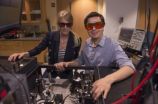(Press-News.org) In general, our knowledge of biology—and much of science in general—is limited by our ability to actually see things. Researchers who study developmental problems and disease, in particular, are often limited by their inability to look inside an organism to figure out exactly what went wrong and when.
Now, thanks to techniques developed at Caltech, scientists can see through tissues, organs, and even an entire body. The techniques offer new insight into the cell-by-cell makeup of organisms—and the promise of novel diagnostic medical applications.
"Large volumes of tissue are not optically transparent—you can't see through them," says Viviana Gradinaru (BS '05), an assistant professor of biology at Caltech and the principal investigator whose team has developed the new techniques, which are explained in a paper appearing in the journal Cell. Lipids throughout cells provide structural support, but they also prevent light from passing through the cells. "So, if we need to see individual cells within a large volume of tissue"—within a mouse kidney, for example, or a human tumor biopsy—"we have to slice the tissue very thin, separately image each slice with a microscope, and put all of the images back together with a computer. It's a very time-consuming process and it is error prone, especially if you look to map long axons or sparse cell populations such as stem cells or tumor cells," she says.
The researchers came up with a way to circumvent this long process by making an organism's entire body clear, so that it can be peered through—in 3-D—using standard optical methods such as confocal microscopy.
The new approach builds off a technique known as CLARITY that was previously developed by Gradinaru and her collaborators to create a transparent whole-brain specimen. With the CLARITY method, a rodent brain is infused with a solution of lipid-dissolving detergents and hydrogel—a water-based polymer gel that provides structural support—thus "clearing" the tissue but leaving its three-dimensional architecture intact for study.
The refined technique optimizes the CLARITY concept so that it can be used to clear other organs besides the brain, and even whole organisms. By making clever use of an organism's own network of blood vessels, Gradinaru and her colleagues—including scientific researcher Bin Yang and postdoctoral scholar Jennifer Treweek, coauthors on the paper—can quickly deliver the lipid-dissolving hydrogel and chemical solution throughout the body.
Gradinaru and her colleagues have dubbed this new technique PARS, or perfusion-assisted agent release in situ.
Once an organ or whole body has been made transparent, standard microscopy techniques can be used to easily look through a thick mass of tissue to view single cells that are genetically marked with fluorescent proteins. Even without such genetically introduced fluorescent proteins, however, the PARS technique can be used to deliver stains and dyes to individual cell types of interest. When whole-body clearing is not necessary the method works just as well on individual organs by using a technique called PACT, short for passive clarity technique.
To find out if stripping the lipids from cells also removes other potential molecules of interest—such as proteins, DNA, and RNA—Gradinaru and her team collaborated with Long Cai, an assistant professor of chemistry at Caltech, and his lab. The two groups found that strands of RNA are indeed still present and can be detected with single-molecule resolution in the cells of the transparent organisms.
The Cell paper focuses on the use of PACT and PARS as research tools for studying disease and development in research organisms. However, Gradinaru and her UCLA collaborator Rajan Kulkarni, have already found a diagnostic medical application for the methods. Using the techniques on a biopsy from a human skin tumor, the researchers were able to view the distribution of individual tumor cells within a tissue mass. In the future, Gradinaru says, the methods could be used in the clinic for the rapid detection of cancer cells in biopsy samples.
The ability to make an entire organism transparent while retaining its structural and genetic integrity has broad-ranging applications, Gradinaru says. For example, the neurons of the peripheral nervous system could be mapped throughout a whole body, as could the distribution of viruses, such as HIV, in an animal model.
Gradinaru also leads Caltech's Beckman Institute BIONIC center for optogenetics and tissue clearing and plans to offer training sessions to researchers interested in learning how to use PACT and PARS in their own labs.
"I think these new techniques are very practical for many fields in biology," she says. "When you can just look through an organism for the exact cells or fine axons you want to see—without slicing and realigning individual sections—it frees up the time of the researcher. That means there is more time to the answer big questions, rather than spending time on menial jobs."
INFORMATION: END
Biology made simpler with clear tissues
2014-08-05
ELSE PRESS RELEASES FROM THIS DATE:
Researchers uncover novel process for creation of fuel and chemical compounds
2014-08-05
MADISON, Wis. — A team of researchers at the University of Wisconsin-Madison has identified the genes and enzymes that create a promising compound — the 19 carbon furan-containing fatty acid (19Fu-FA). The compound has a variety of potential uses as a biological alternative for compounds currently derived from fossil fuels.
Researchers from the Great Lakes Bioenergy Research Center (GLBRC), which is headquartered at UW-Madison and funded by the U.S. Department of Energy, discovered the cellular genomes that direct 19Fu-FA's synthesis and published the new findings Aug. ...
Baby aspirin? Many doctors don't recommend, despite guidelines
2014-08-05
A majority of middle-aged men and women eligible to take aspirin to prevent heart attack and stroke do not recall their doctors ever telling them to do so, according to a University of Rochester study of a national sample of more than 3,000 patients.
Published online by the Journal of General Internal Medicine, the finding illustrates a common disconnect between public health guidelines and what occurs in clinical practice. The UR study is consistent with other research showing that physicians often do not recommend aspirin as prevention therapy to the general population, ...
Pistachios may lower vascular response to stress in type 2 diabetes
2014-08-05
Among people with type 2 diabetes, eating pistachios may reduce the body's response to the stresses of everyday life, according to Penn State researchers.
"In adults with diabetes, two servings of pistachios per day lowered vascular constriction during stress and improved neural control of the heart," said Sheila G. West, professor of biobehavioral health and nutritional sciences. "Although nuts are high in fat, they contain good fats, fiber, potassium and antioxidants. Given the high risk of heart disease in people with diabetes, nuts are an important component of a ...
Watching chemistry in motion: Chemical environments mapped using molecular vibrations
2014-08-05
Scientists have long known that a molecule's behavior depends on its environment. Taking advantage of this phenomenon, a group of researchers at the University of Chicago developed a new technique to map microscopic environments using the vibrations of molecules.
"It's a special new advance that will be broadly useful in studies of molecular and materials phenomena," said Andrei Tokmakoff, the Henry G. Gale Distinguished Service Professor in Chemistry at UChicago. He and two of his associates report their new technique in a paper published online in the journal Optics ...
Physicists eye neural fly data, find formula for Zipf's law
2014-08-05
Physicists have identified a mechanism that may help explain Zipf's law – a unique pattern of behavior found in disparate systems, including complex biological ones. The journal Physical Review Letters is publishing their mathematical models, which demonstrate how Zipf's law naturally arises when a sufficient number of units react to a hidden variable in a system.
"We've discovered a method that produces Zipf's law without fine-tuning and with very few assumptions," says Ilya Nemenman, a biophysicist at Emory University and one of the authors of the research.
The ...
'Treatments waiting to be discovered' inside new database
2014-08-05
Your genes are blueprints for proteins, and molecules called microRNA can help to determine how often these genetic blueprints are manufactured into proteins. Researchers often ask what microRNA regulates a gene related to disease. Or what gene is regulated by a microRNA found in sick patients? The answers to these questions could help doctors and researchers manipulate protein levels in the body that cause disease, especially cancer. A University of Colorado Cancer Center study recently published in the top-ranked journal Nucleic Acids Research (NAR) describes a database ...
Monthly preventative treatment with a new drug combination reduces malaria in children
2014-08-05
Preventative treatment with a monthly dose of a newer antimalarial drug can reduce the risk of malarial infection among young children, according to a study published in this week's PLOS Medicine. The study, conducted by Victor Bigira and colleagues at San Francisco General Hospital and the Makerere University College of Health Sciences in Kampala, Uganda, finds that treating young children with dihydroartemisinin-piperaquine (DP) decreased their risk of contracting malaria.
Preventative treatment of malaria is a useful strategy to protect young children in Africa, but ...
Pregnant women are often given inappropriate treatment for malaria
2014-08-05
Not all pregnant women with symptoms of malaria seek care from their formal healthcare system and if they do seek care, they may be given inappropriate treatment because healthcare providers often fail to adhere to the standard (World Health Organization-WHO) diagnostic and treatment guidelines, according to a study by UK researchers published in this week's PLOS Medicine.
The authors (led by Jenny Hill from the Liverpool School of Tropical Medicine) reached these conclusions by reviewing all relevant studies that investigated the factors that affect pregnant women's ...
A campaign involving Muslim clerics has increased uptake of polio vaccination in Nigeria
2014-08-05
A coalition campaign involving imams, Islamic school teachers, traditional rulers, doctors, journalists, and polio survivors is gradually turning the tide against polio vaccine rejection in northern Nigeria, according to experts from Nigeria writing in this week's PLOS Medicine.
Sani-Gwarzo Nasir (from the Federal Ministry of Health in Nigeria) and colleagues describe how anti-polio propaganda, misconceptions, and violence against vaccinators present huge challenges to polio eradication in Nigeria but perhaps most profound is the rejection of vaccination by Muslim clerics.
However, ...
Just one simple question can identify narcissistic people
2014-08-05
COLUMBUS, Ohio – Scientists have developed and validated a new method to identify which people are narcissistic: just ask them.
In a series of 11 experiments involving more than 2,200 people of all ages, the researchers found they could reliably identify narcissistic people by asking them this exact question (including the note):
To what extent do you agree with this statement: "I am a narcissist." (Note: The word "narcissist" means egotistical, self-focused, and vain.)
Participants rated themselves on a scale of 1 (not very true of me) to 7 (very true of me).
(How ...



